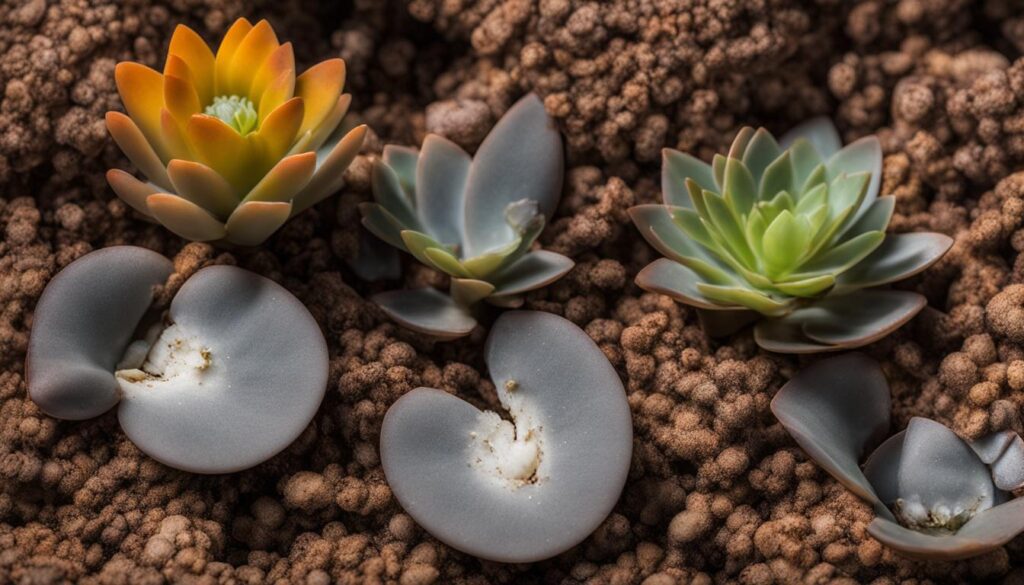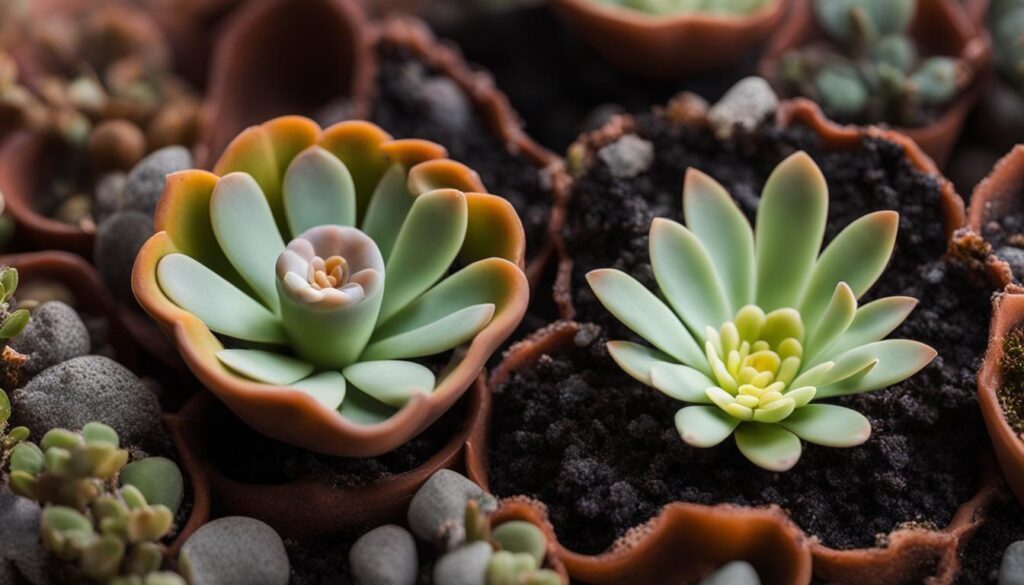Lithops, also known as “living stones,” are unique succulent plants that have become increasingly popular in modern gardening. While lithops splitting may be alarming for some plant enthusiasts, it is actually a normal part of their growth cycle. In this section, we will explore the characteristics of lithops and why they split.
Post Summary
- Lithops splitting is a natural process and a sign of maturity and reproduction.
- Resist the urge to intervene when you notice your lithops splitting.
- Proper care includes providing adequate light and drainage for your lithops.
- Water lithops according to seasonal needs to avoid overwatering.
- Lithops multiply slowly and can be easily propagated through leaf separation after 5 years.
Are Lithops Supposed to Split?
Yes, splitting is a natural and expected part of the lithops’ growth cycle. Lithops will typically split when they are ready to produce new leaves or flower buds. This process usually starts at the edges of the existing leaves, and a gap appears as new leaves emerge. The old leaves will eventually drop off and be replaced with new ones. Splitting is a sign that the lithops is maturing and reproducing.
As the lithops split, it is fascinating to observe the intricate patterns and colors that emerge. Each new set of leaves brings its own unique characteristics, adding to the allure of these captivating plants. While some may find the splitting process unsettling, it is essential to remember that it is a natural occurrence and part of the lithops’ life cycle.
“The splitting of lithops is nature’s way of renewing and rejuvenating the plant. It is an exciting and beautiful process to witness as the plant transforms and prepares for new growth,” says renowned botanist Dr. Emily Green.
Reasons for Lithops Splitting
Lithops split for several reasons, primarily to ensure their survival and reproduction. Splitting allows the lithops to shed old leaves that may have become damaged or depleted of nutrients. By shedding these leaves and producing new ones, the plant can continue to thrive and maintain its health.
Furthermore, splitting is a means for lithops to reproduce. As the lithops split, it creates space for new leaves to emerge, increasing the plant’s overall size and allowing for the development of flower buds. These flowers, when pollinated, can lead to the production of seeds and the creation of new lithops.
| Reasons for Lithops Splitting | Natural Process of Lithops Splitting |
|---|---|
| Shedding old leaves | Sign of maturing and reproducing |
| Creating space for new leaves and flower buds | Allows for growth and the production of seeds |
| Maintaining plant health and vitality | Ensures continued survival and reproduction |
In conclusion, lithops splitting is a natural and necessary process for the plants. It signifies growth, maturity, and reproduction. By understanding the reasons behind lithops splitting and appreciating the beauty of this transformation, we can better care for these remarkable succulents and enjoy their unique characteristics.
What To Do When Lithops Split
When you notice your lithops splitting, it is important to resist the urge to intervene. Splitting is a natural process, and the best thing to do is to let it happen on its own. Avoid watering the lithops during this time, as it can disrupt the splitting process.
Provide proper care by ensuring the pot is large enough and provides proper drainage. Lithops prefer well-draining soil, so make sure the pot has adequate drainage holes. This will help prevent waterlogged soil, which can lead to root rot.
Additionally, make sure the lithops gets plenty of light. These desert-dwelling plants thrive in bright sunlight. Place your lithops in a sunny spot, such as a south or west-facing window. If you’re growing them outdoors, choose a location with full sun exposure.
Steps to take when lithops are splitting:
- Do not interfere: Let the splitting process happen naturally.
- Avoid watering: Refrain from watering the lithops during the splitting phase.
- Provide proper pot and soil: Ensure the pot is large enough with good drainage. Use well-draining soil.
- Give ample sunlight: Place the lithops in a sunny spot with plenty of light.
By following these guidelines, you can help ensure that your lithops continues to thrive during its splitting cycle. Remember, caring for lithops requires patience and allowing nature to take its course.
In summary, lithops multiplication is a slow process that requires patience. Propagating lithops through division is a reliable method to create new plants once they reach maturity. By understanding the natural growth cycle of lithops and providing proper care, enthusiasts can enjoy the gradual multiplication of these fascinating “living stones” in their gardens.
Conclusion on Identifying Lithops Splitting
In conclusion, understanding lithops splitting is crucial for successful care and maintenance of these unique succulent plants. Splitting is a natural and expected part of their growth cycle, indicating maturity and reproduction. When you notice your lithops splitting, it is important not to intervene, but instead let the process happen naturally.
Proper care is essential during the splitting cycle. Ensure your lithops receives adequate light and is planted in a pot with proper drainage. Additionally, follow the recommended watering guidelines based on the season. By providing the right conditions, you can support the lithops’ growth and help it thrive.
Remember to be patient when caring for lithops. They multiply slowly over time, with propagation through leaf separation and repotting being the preferred method. Avoid attempting to multiply lithops through splitting, as it is not recommended.
In summary, by recognizing and respecting the natural process of lithops splitting, you can enjoy the beauty and uniqueness of these “living stones” in your garden. With the right care and a little patience, your lithops will continue to flourish and bring a touch of the extraordinary to your succulent collection.
FAQ
How do I know if my lithops are splitting?
Splitting lithops will have a gap at the edges of their existing leaves where new leaves are emerging. This is a normal part of their growth cycle.
Is lithops splitting a natural process?
Yes, splitting is a natural and expected part of lithops’ growth cycle. It is a sign of maturity and reproduction.
What should I do when my lithops split?
It is best to let the splitting process happen naturally without intervening. Avoid watering the lithops during this time and make sure it has proper care, including adequate pot size, drainage, and light.
How often should I water my lithops?
Lithops have different watering needs depending on the season. During summer, they should not be watered. In winter, avoid watering as their new leaves absorb moisture from the old ones. In spring, water lightly to aid in new growth. In autumn, water regularly but only when the soil has dried out since the last watering.
How fast do lithops multiply?
Lithops generally reproduce slowly and can take many years to multiply. After reaching the age of 5 years, they can be easily propagated by separating their leaves and repotting them.
What Are the Signs of Lithops Splitting and How Long Does It Take?
Lithops splitting timeline can vary, but there are signs to watch for. When the fissure widens, it’s a clear indication the splitting process has begun. This can take several days or even weeks to complete. Keep an eye on your lithops to track its progress.











